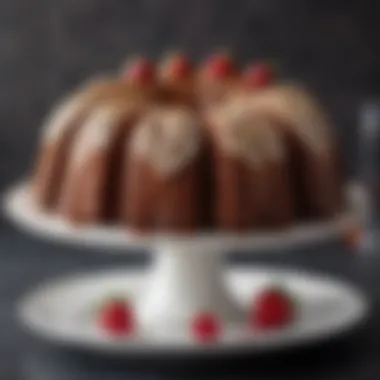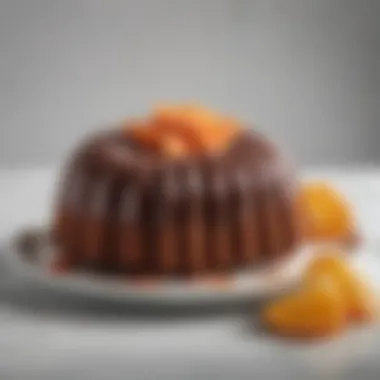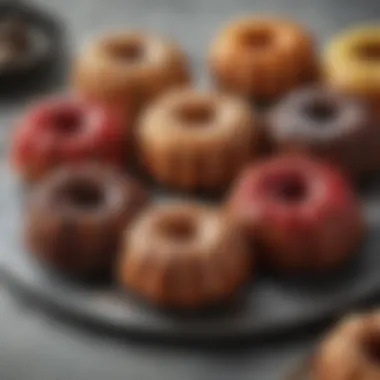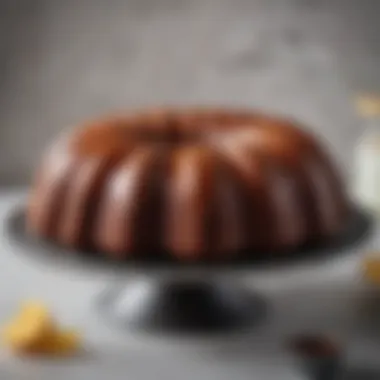Exploring the Half Bundt Cake Pan: A Comprehensive Guide


Intro
The half bundt cake pan is a unique addition to any baker's arsenal. This pan offers a new dimension to traditional bundt baking, allowing for creative desserts that capture attention and delight the palate. Unlike its full-sized counterpart, the half bundt is designed to produce smaller, elegantly shaped cakes that are versatile for numerous occasions.
Understanding the half bundt cake pan involves exploring its design and functionality. This guide covers the essentials of utilizing this innovative kitchen tool effectively. By examining its structure, you will appreciate how it contributes to even baking and easy release of cakes. Furthermore, we discuss maintenance practices to ensure longevity and optimal performance of the pan.
One of the standout features of the half bundt cake pan is its versatility. Not only can it accommodate classic recipes, but it also opens doors to contemporary twists, thus expanding your baking repertoire. Whether you are cooking for a small gathering or simply seeking to enjoy a sweet treat at home, the half bundt cake pan makes baking enjoyable and rewarding.
To assist with your culinary journey, this article will provide:
- A thorough overview of various recipes suitable for the half bundt cake pan.
- Detailed lists of ingredients, along with notes on potential substitutions and variants.
- Valuable tips for achieving exceptional results.
This exploration of the half bundt cake pan will not only enhance your baking skills but also encourage an appreciation for this specialized tool.
Preamble to Bundt Cake Pans
Bundt cake pans have become essential tools in the kitchens of both amateur bakers and seasoned professionals. Their distinctive shape and large surface area allow for even baking, which is crucial for achieving the perfect texture in cakes. Using a bundt pan can transform a simple recipe into a visually stunning dessert. This article will explore the fascinating world of the half bundt cake pan, a unique variation that enhances the traditional bundt design.
Historical Significance
The bundt cake originated in Europe, notably in Germany, where it was influenced by traditional kugelhopf cakes before making its way to America. In the 1950s, the bundt cake pan gained popularity in the United States, largely thanks to the promotion by the Nordic Ware company. The design proved to be not only practical but also aesthetically pleasing. This historical context highlights the cultural journey of the bundt cake, and it establishes the foundation for understanding the pan's significance today.
Furthermore, the bundt cake embodies moments of celebration. Family gatherings often feature a beautifully baked bundt cake as the centerpiece. From birthdays to holidays, it marks special occasions and reflects a sense of community and togetherness. Understanding this history provides insight into why baking a bundt cake remains a cherished tradition.
Evolution of Cake Pans
The evolution of cake pans is an interesting reflection of changing baking practices and preferences. Initially, cakes were baked in simple, round pans. As bakers sought to create more intricate designs, various shaped pans emerged, culminating in the creation of the bundt cake pan. The half bundt cake pan is an evolved version of this classic, offering unique possibilities for modern bakers.
As baking technology advanced, so did the materials used in pan construction. Traditional metal pans have been complemented by newer options, including silicone and ceramic. Each material offers distinct advantages, such as easier release of cakes and varying degrees of heat conductivity.
Overall, the half bundt cake pan’s design and functionality showcase how baking tools have adapted over time to meet the demands of home bakers. As culinary interests shifted toward creativity and versatility, the half bundt cake pan emerged as a relevant answer.
Design Features of Half Bundt Cake Pans
Understanding the design features of half bundt cake pans is crucial for both novice and experienced bakers. These features contribute to the pan’s functionality, making it a valuable tool in the kitchen. From the materials used to the specific shapes, every aspect plays a role in baking processes and outcomes. Investing time in knowing these details can significantly enhance the baking experience.
Materials Used
Metal
Metal is a common choice for half bundt cake pans. The main reason for its popularity lies in its excellent heat conductivity. When baking, it allows for even heat distribution, which can result in better baking outcomes. This feature of metal not only helps in achieving a golden crust but also ensures that the interior of the cake is thoroughly cooked. However, metal pans need proper maintenance to avoid rust and scratches.
Key characteristic: Durability. Metal pans are often strong and can last for many years if cared for properly.
Advantages: Quick heating and even baking.
Disadvantages: Requires careful greasing and can be prone to scratching.
Bakeware Coatings
Bakeware coatings, like non-stick, are another important aspect to consider. These coatings provide a barrier that helps in easy release of cakes from the pan. It reduces the chances of sticking, which is a common issue when working with traditional metal pans. This characteristic makes coated pans user-friendly, especially for individuals new to baking.
Key characteristic: Non-stick properties. These coatings help cakes slide out effortlessly, minimizing the risk of damage.
Advantages: Easy to clean and less greasing required.


Disadvantages: Coatings may wear off over time, affecting the pan's life.
Silicone Options
Silicone molds are becoming more popular for half bundt cake pans. They offer flexibility and can withstand a wide range of temperatures. Silicone pans provide the benefit of being lightweight, which makes handling easier. The flexibility also aids in the removal of the cake without needing extensive tools.
Key characteristic: Flexibility and ease of use. The structure allows for varied baking methods and easy cleanup.
Advantages: Quick release and dishwasher-safe.
Disadvantages: May not give the same crisp edge as metal pans, and care must be taken with heat levels.
Shape and Structure
Unique Configuration
The half bundt cake pan's shape is distinct, providing a unique baking experience. The classic bundt structure allows for greater surface area and creates a particular aesthetic that enhances presentation. This configuration is beneficial for achieving a cake with a nice shape and texture. The design encourages heat circulation, leading to evenly baked results.
Key characteristic: Aesthetic design. The unique pattern not only makes the cake attractive but can also influence taste through texture variations.
Advantages: Enhanced visual appeal and texture.
Disadvantages: The unique shape may limit certain recipes that require a uniform structure.
Dimension Variations
Half bundt cake pans come in various sizes and dimensions, accommodating different baking needs. With various options available, bakers can select the perfect size for their baking projects. This feature allows for creativity in cake sizes and servings.
Key characteristic: Versatility in dimensions. It enables bakers to experiment with portion sizes and presentation.
Advantages: Suitable for varying occasions, from small gatherings to larger celebrations.
Disadvantages: Confusion may arise when adapting recipes for different dimensions, leading to potential baking issues.
Advantages of Using a Half Bundt Cake Pan
The half bundt cake pan is not just a kitchen tool; it represents an invaluable ally for anyone serious about baking. Its benefits cater to a wide audience, whether you are a novice to baking or a seasoned enthusiast. Let's explore the advantages of using a half bundt cake pan, which include efficient baking, versatility in recipes, and enhanced aesthetic appeal. Each of these elements contributes significantly to the baking process and outcomes.
Efficient Baking
One of the standout features of the half bundt cake pan is its ability to promote efficient baking. The unique shape allows the batter to have greater heat exposure, ensuring that it cooks evenly throughout. In traditional round cake pans, the edges may often cook faster than the center. The half bundt design helps mitigate this issue.
In addition, the size of this pan encourages smaller portions without sacrificing flavor or texture. For those who want to indulge but avoid heavy desserts, this pan is the perfect solution. Here are some points to consider:
- Reduced Cooking Time: Smaller cakes tend to bake faster, reducing the overall wait time for your dessert.
- Even Baking: The design promotes uniform heat distribution, leading to an even bake.
- Less Wastage: With smaller servings, you decrease the likelihood of leftover cake, minimizing waste.
Versatility in Recipes
A half bundt cake pan is remarkably versatile. Its shape lends itself well to a wide variety of recipes. From dense, rich chocolate cakes to lighter, airy cakes like angel food, this pan can accommodate diverse ingredients and styles. Home bakers can experiment with adding unique flavors and textures without worrying about the outcome. Here are some examples of what you can create:
- Classic Bundt Recipes: Vanilla or chocolate cakes that are always crowd-pleasers.
- Novel Flavor Combinations: Unique mixes like almond and orange or lavender lemon.
- Savory Options: Think about using the pan for bread or quiche, showcasing its adaptability.
Aesthetic Appeal
The half bundt cake pan is also a feast for the eyes. The intricate design of the finished cake adds elegance to any table setting. Presentation matters in baking, and the half bundt shape allows bakers to create visually appealing desserts without complicated decorating techniques. The unique silhouette automatically grabs attention and elevates the everyday dessert experience. Consider the following:


- Simple Presentation: Minimal decoration is needed thanks to the pan’s sculptural qualities.
- Impressive Slices: When you cut into a half bundt cake, each slice reveals a beautifully formed pattern.
- Versatile Usage for Special Occasions: Its charm makes it suitable for birthdays, holidays, or everyday treats.
"Utilizing a half bundt cake pan combines practical efficiency with creative expression, allowing bakers to enjoy the process while achieving impressive results."
To summarize, the advantages of using a half bundt cake pan are clear. It promotes efficient baking, supports a wide variety of recipes, and enhances the visual appeal of your desserts. Incorporating this pan into your baking routine will likely lead to rewarding experiences in the kitchen and delightful results on your plate.
Recipes for the Half Bundt Cake Pan
The section on recipes for the half bundt cake pan is essential in this article. It not only showcases the versatility of this innovative baking tool but also provides practical applications for both novice and experienced bakers. The unique design allows for different flavors and presentations, making it a favored option in various baking scenarios. Additionally, these recipes accommodate the pan's size, maximizing its usability while maintaining quality and taste.
Classic Recipes
Vanilla Bundt Cake
Vanilla bundt cake is a timeless recipe that highlights the half bundt cake pan's strengths. Its simplicity allows bakers to focus on technique without distracting flavors. The airy texture and subtle sweetness make it a staple in many homes. The key characteristic of this cake is its moist crumb, which pairs well with various glazes or toppings. Using quality vanilla extract enhances its flavor profile, making this cake not only a delicious option but also one that showcases baking skills. However, it requires careful attention to room temperature ingredients for optimal results.
Chocolate Bundt Cake
Chocolate bundt cake serves as another classic choice that shines in a half bundt cake pan. This recipe is beloved due to its rich flavor and decadent texture. The dense chocolate cake provides a satisfying contrast to lighter varieties, making it an appealing option for dessert lovers. A unique feature of this cake is its adaptability; it can be paired with a variety of icings or dustings such as powdered sugar. However, bakers should ensure proper greasing to prevent sticking, as chocolate can sometimes cause issues in the pan.
Creative Flavor Combinations
Zesty Lemon Bundt Cake
Zesty lemon bundt cake offers a refreshing twist that can brighten up any dessert table. This cake is characterized by its vibrant flavor and moist texture, making it a popular choice in warmer months. The integration of fresh lemon juice and zest elevates the cake, allowing for a burst of citrus flavor. This unique feature sets it apart from more traditional recipes. The only downside may be that lemon flavor can vary based on the quality of the fruit used, impacting the overall taste.
Spiced Pumpkin Bundt Cake
Spiced pumpkin bundt cake introduces a seasonal favorite that is perfect for autumn baking. The use of pumpkin puree yields a moist cake that is rich in flavor. The warm spices, including cinnamon and nutmeg, create an inviting aroma. The cake's unique feature is its ability to remain moist longer than many traditional cakes. Moreover, this recipe encourages different variations, such as incorporating nuts or chocolate chips. However, its richness may not appeal to everyone, requiring bakers to consider their audience.
Baking Techniques Specific to Half Bundt Cake Pans
When using a half bundt cake pan, implementing the right baking techniques is essential for achieving optimal results. This becomes especially crucial as the unique shape and size of the pan can affect the baking process, leading to variations in texture and taste. Mastering these techniques can elevate your baking experience and enhance the quality of your cake.
Prepping the Pan
Greasing Methods
Greasing the pan properly is a fundamental step that impacts the ease of cake removal post-baking. Using either butter or non-stick cooking spray are common choices. Butter provides a richer flavor and a beautiful golden crust.
Key characteristic: Butter adheres well to the pan's surface. However, it must be applied generously, making sure all crevices are coated. This method is beneficial for its flavor-enhancing properties.
On the other hand, non-stick cooking spray offers convenience, ensuring an even coating with minimal effort. The unique feature of this method is its quick application, reducing hands-on prep time. Yet, too much spray can lead to a greasy finish, which may not be desired.
Flouring Techniques
Flouring the pan after greasing provides an additional layer of protection against sticking. This technique helps to create a barrier between the cake and the pan, which is particularly important for intricate designs of half bundt cakes.
Key characteristic: A dusting of flour creates a non-stick surface, improving the chances of a clean release once the cake is baked. This is a popular choice among bakers wanting to avoid the hassle of a stuck cake.
A unique feature of this method is its flexibility; bakers can use various types of flour, such as all-purpose flour or even cocoa powder for chocolate cakes. However, excess flour can lead to a dusty finish on the cake, which might be unappealing. Finding the right balance is key.
Optimal Baking Times and Temperatures
Getting the timing and temperature right is vital for achieving the perfect bake in a half bundt cake pan. Most recipes suggest a temperature range between 325°F to 350°F. Baking at these temperatures ensures that the cake rises evenly and develops a consistent texture throughout.


In general, a half bundt cake requires about 25 to 35 minutes of baking time, but the specifics can vary based on the recipe used. Testing for doneness, such as inserting a toothpick into the center, is crucial. A clean result indicates the cake is ready. Be mindful, as underbaking may yield a soggy center, while overbaking can dry out the edges, harming the overall quality of your cake.
Key takeaway: Understand how each method, from greasing to optimal baking, significantly influences the outcome of your cake in a half bundt pan. Pay attention to details, and you'll enhance your baking skills and produce beautifully baked cakes.
Maintenance and Care of Half Bundt Cake Pans
Maintaining and caring for your half bundt cake pan is crucial for ensuring its longevity and performance. Proper care not only enhances your baking results but also prevents issues that could arise from neglect, like sticking or scratching. A well-maintained pan can provide you years of excellent service. Therefore, understanding the best practices for cleaning and storing these pans is essential for any baking enthusiast.
Cleaning Recommendations
Keeping your half bundt cake pan clean is fundamental for its function and appearance. Here are some tips to maintain its cleanliness:
- Immediate Cleaning: After using the pan, clean it as soon as possible. This helps prevent batter residue from hardening, which makes cleaning more time-consuming.
- Gentle Hand Washing: Avoid using a dishwasher if possible, especially for non-stick pans. Instead, wash by hand with warm soapy water and a soft sponge to avoid scratching the surface. This method yields better results for the longevity of the pan.
- Remove Stuck Residue: For stubborn residue, create a paste of baking soda and water. Apply it to the affected area and let it sit for about 15 minutes before gently scrubbing it away with a soft cloth.
Remember, harsh chemicals can damage the coating. Stick to mild detergents for optimal care.
Storage Tips
How you store your half bundt cake pan is as important as how you clean it. Proper storage can help prevent damage and make your cooking space more organized:
- Stacking Considerations: Avoid stacking heavy items on top of your bundt pan, as this can cause warping. If you need to stack, place a soft cloth between pans to reduce the risk of scratches.
- Hanging Storage: Consider hanging the pan if space allows. This reduces the chance of damage and keeps it readily accessible.
- Covering: When storing, cover the pan with a lightweight cloth to prevent dust accumulation. This keeps it clean and ready for your next baking adventure.
Taking steps to care for and maintain your half bundt cake pan will ensure that it remains a reliable tool in your kitchen for many delicious desserts.
Common Issues and Solutions
Understanding common issues and their solutions when using a half bundt cake pan is crucial for achieving successful baking results. Identifying these potential problems can save time and avoid frustration. Through this section, we will delve into the most frequent issues encountered with half bundt cake pans and offer practical solutions to enhance your baking experience.
Sticking Problems
Sticking can be a significant issue when using a half bundt cake pan. This occurs when the cake adheres to the sides of the pan, making it difficult to release the baked item without damaging it. To prevent sticking, proper preparation of the pan is key. Here are several methods:
- Greasing: Use a generous amount of butter or cooking spray on the inside of the pan, covering all the detailed areas. This provides a barrier that helps the cake to slide out easily.
- Flouring: After greasing, dust the pan with flour. This extra layer ensures non-stick properties, especially on intricate designs.
- Using Parchment Paper: For added assurance, cut a circle of parchment paper to fit the bottom of the pan. This will help in effortless release, particularly for moist cakes.
If you experience sticking despite these precautions, it may indicate the cake was not fully baked or cooled appropriately. Allowing the cake to cool in the pan for a few minutes before inverting it onto a wire rack can help as well.
Uneven Baking
Uneven baking can lead to a cake that is overcooked on one side while remaining undercooked on the other. This might stem from a few factors related to the specific characteristics of half bundt cake pans:
- Oven Temperature: Ensure your oven accurate. An oven thermometer can help monitor the temperature and adjust as needed. Incorrect temperatures can lead to poor results.
- Placement in the Oven: Position the pan in the center of the oven to ensure even heat distribution. Avoid placing it too close to the walls of the oven, which may cause uneven cooking.
- Baking Time: Each recipe has its specific time frame. It’s essential to test for doneness with a toothpick inserted into the center. If it comes out clean, the cake is ready.
Maintaining awareness of these techniques and considerations can significantly improve your baking experience. Proper care will help you create delightful cakes, fulfilling both your creativity and taste.
Closure: Embracing the Half Bundt Cake Pan
The half bundt cake pan is more than just a kitchen tool; it represents a shift in how baking can be approached. Its unique design caters to those who appreciate efficiency and creativity. In today's baking world, this pan allows for a blend of tradition and innovation. As home bakers explore its capabilities, they can create an array of desserts that may not have been feasible with standard pans.
Embracing the half bundt cake pan means recognizing its potential in various baking scenarios. This includes small gatherings where a full bundt may be too much, or in recipe adaptations that call for specific treats. It encourages bakers to think beyond the traditional cake structure. This pan also simplifies portioning and serving, making it attractive for families and single individuals alike.
Future of Bundt Cake Baking
The future of bundt cake baking is likely to evolve as culinary trends shift. With a focus on health and convenience, half bundt cake pans could become a staple in many kitchens. As recipes become more diverse, bakers are encouraged to experiment with flavors and textures, integrating seasonal ingredients into their creations. Trends toward gluten-free and vegan baking are likely to merge with bundt cake adaptations, expanding what is possible with this tool.
Moreover, as more people turn to home baking, the half bundt pan will serve a dual role. It can satisfy cravings while being manageable for those with limited experience. The ease of use allows anyone to become comfortable with baking techniques.
In summary, the half bundt cake pan is poised to take its place in modern kitchens, encouraging bakers to innovate while holding onto the joy traditional bundt cakes bring. With more resources available online, including user tips and unique recipes, the potential for success with this pan is immense.
"Baking with a half bundt cake pan is a journey that invites both creativity and precision, a combination that caters to both novice and seasoned bakers."
As the culinary landscape continues to develop, it is clear that embracing innovative tools like the half bundt cake pan enhances the overall baking experience.







